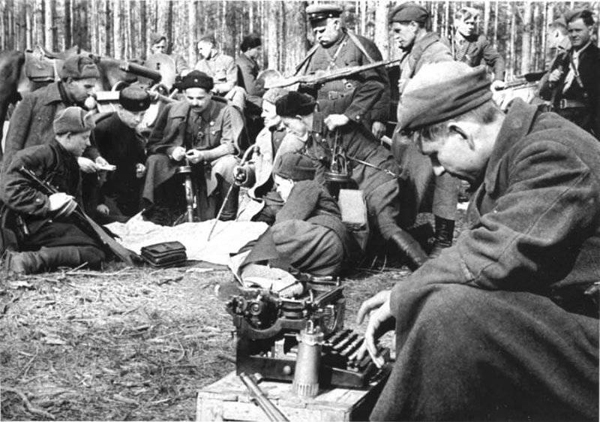Soviet partisans in Ukraine, 1941–5
Soviet partisans in Ukraine, 1941–5. In Ukraine, Soviet partisans played a less important role in the Soviet war effort against the Germans than they did in other parts of the Soviet Union. Recruited from Party cadres left behind the German lines, escapees from German prisoner of war camps, and refugees from the German terror, they found little support among the population and, except for the northeastern region, no suitable terrain for their operations.
At the end of June 1941, immediately after the Germans crossed the Soviet border, the Central Committee of the All-Union Communist Party (Bolshevik) ordered Party members to organize an underground on occupied territories. In 1941 underground cells sprang up in a few Ukrainian cities, but most Party members ignored the order. The first partisan detachments appeared in Chernihiv oblast and Sumy oblast. They developed out of M. Popudrenko's and Sydir Kovpak's underground groups, which were joined by small army units that broke through the German encirclement of the Soviet forces east of Kyiv. It was only in the spring of 1942, when these partisans established a radio link with Moscow and received special reinforcements dropped by parachute, that they began to show some activity. Apart from two other partisan detachments, which sprang up at the end of 1941 and were quickly wiped out by the Germans, one (500 men) in the Nikopol and Kryvyi Rih regions and the other (400 men) in the eastern Dnipropetrovsk region, there were no other Soviet partisans in Ukraine at the time. A significant partisan movement developed by the spring of 1942 in occupied Belarusian and southwestern Russian territories, where 80 percent of the Soviet partisan activity was concentrated. In Ukraine, Soviet partisans achieved a significant strength only in mid-1943.
Soviet partisans came under the Ministry of State Security, not under the defense ministry. On 30 May 1942 the Central Staff of the USSR Partisan Movement was set up in Moscow, and on 20 June the CC CP(B)U established the Ukrainian Staff of the Partisan Movement in Voroshylovhrad. The nominal chief of the Ukrainian Staff was Nikita Khrushchev, but its actual chief was Tymofii Strokach, deputy commissar of the NKVD of the Ukrainian SSR. On its orders Sydir Kovpak and A. Saburov conducted an extended raid in October 1942 to March 1943 from the Briansk forests into northern Ukraine. German troops in the region were sparse; hence, they encountered little resistance. Then, in May 1943, Kovpak was sent on a long raid from Putyvl across Volhynia to the Carpathian Mountains to cut German supply lines and to demonstrate Soviet power in Volhynia and Galicia, where Ukrainian Insurgent Army (UPA) forces were forming. His force was crushed by the Germans at Deliatyn on 1 August, and some of its surviving bands were wiped out by the UPA. In spite of the losses, the raid had an important psychological effect on the Ukrainian population: it destroyed its belief in German invincibility. The returning survivors were assigned to the First Ukrainian Partisan Division under the command of Petr Vershigora, which in January–July 1944 conducted a raid from Volhynia through northwestern Galicia, the Kholm region, Podlachia, and Belarus. The other partisan raids in 1943—led by M. Naumov in southern Ukraine and Ya. Melnyk and Oleksii Fedorov in Right-Bank Ukraine and Volhynia—were less significant. V. Behma's and Col D. Medvedev's Soviet units were based in Volhynia, but their operations extended into adjacent regions. As the Red Army advanced through Ukraine the partisan movement grew rapidly. According to Soviet sources there were 13,300 partisans in Ukraine at the beginning and 43,500 at the end of 1943.
Small partisan units and Komsomol underground groups that arose spontaneously and had a distinctly national profile constituted a special branch of the Soviet partisan movement in Ukraine. They had no contact with the Ukrainian Staff and often were treated as hostile forces by the Soviets. For many years after the war, they were not recognized as Soviet partisans by Soviet authorities. The Young Guards in the Donbas, an underground group in Vinnytsia (arrested by the NKVD in 1944), a unit in the Chernihiv region (wiped out by Oleksii Fedorov in March 1942), and Capt I. Kudria's group in the Dykanka forests are some examples of such groups.
At the beginning of 1944 the number of Soviet partisans in Ukraine rose to 47,800, or about 10 percent of the USSR total. Moving west in advance of the Red Army, the partisans assumed the role of a vanguard. The leading Soviet partisan units in Ukraine were under Petr Vershigora, M. Naumov, I. Artiukhov, V. Shangin, and M. Shukaev. The last unit was defeated by the UPA in the Carpathian Mountains. The partisans pursued the Germans into Poland, where Vershigora's division distinguished itself, and into Czechoslovakia. The Ukrainian Staff directed the Soviet partisan movement until it was abolished on 1 June 1945.
BIBLIOGRAPHY
Klokov, V.; Kulyk, I.; Slynko, I. Narodna borot’ba na Ukraïni u roky Velykoï Vitchyznianoï viiny (Kyiv 1957)
Armstrong, J. (ed). Soviet Partisans in World War II (Madison 1964)
Ukraïns’ka RSR u Velykii Vitchyznianii viini Radians’koho soiuzu 1941–1945, 3 vols (Kyiv 1967–9)
Kucher, V. Partyzans’ki kraï i zony na Ukraïni v roky Velykoï Vitchyznianoï viiny, 1941–1944 (Kyiv 1974)
Cooper, M. The Phantom War: The German Struggle against Soviet Partisans, 1941–1944 (London 1979)
Andrij Makuch, Lev Shankovsky, Yevhen Stakhiv
[This article originally appeared in the Encyclopedia of Ukraine, vol. 5 (1993).]

